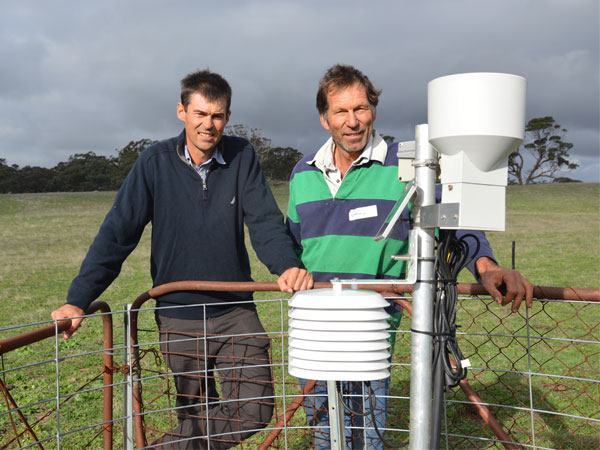Measure moisture for better pasture management
Measuring subsoil moisture levels can take the guesswork out of planning future stocking rates, a new study by the Barossa Improved Grazing Group (BIGG) suggests.
The study, funded by the Adelaide and Mount Lofty Ranges Natural Resources Management Board and the Australian Government’s National Landcare Programme, analysed data from three experimental weather and soil monitoring stations set up in different types of soils on pastures across the Barossa.
It is the first time in Australia that a farming systems group has demonstrated soil moisture monitoring in pastures.

Barossa Improved Grazing Group (BIGG) technical facilitator Brett Nietschke, with Graham Keynes, producer host of BIGG’s
demonstration weather station located at Keyneton.
BIGG technical facilitator Brett Nietschke says knowing how much moisture your soil is holding enables producers to help plan their stocking rates well in advance.
The research was presented recently in Adelaide at Animal Production 2016, the biennial conference of the Australian Society of Animal Production.
The study found that the total amount of water which can be accessed by the pasture, measured up to 85cm below the surface, varied dramatically among the three Barossa sites at Flaxman Valley (112mm), Keyneton (60mm) and Koonunga (82mm).
“We were quite surprised at the results,” said Brett. “We expected the soil moisture capacity to be less at Flaxman Valley, because the soils are sandy there. But it turns out the Flaxman moisture content was nearly double that at Keyneton. This might be because the Flaxman Valley soils have very high organic content which helps increase the moisture holding capacity.
“This information, coupled with three month weather forecasts, can give local producers the ability to critically evaluate their livestock numbers. If soil moisture content gets below a certain level, for example, combined with a dry outlook, producers can get in early and reduce stock, or seek agistment and buy feed before prices rise.
“Well before pastures become exhausted, you’ll be able to reduce stock, maintain some groundcover, reduce soil erosion and invasion by broadleaf weeds.
“The weather stations also monitor temp/rainfall/humidity/wind speed – primary producers can use this information to help verify the current conditions for spraying or the current conditions for livestock chill.”
Brett says the data collected on soil moisture is representative of the main soil types in the Barossa and would be useful to any pasture producers in the area. Producers in other states have expressed interest in setting up similar systems.
The project has just received a Sustainable Agriculture Industry Support grant from Natural Resources Adelaide and Mt Lofty Ranges (AMLR) to enable the weather stations to continue operating until December 2018.
The soil moisture data can be downloaded for free on the BIGG website: http://biggroup.org.au/project/soil-moisture-monitoring/



